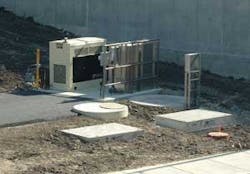A Grand Stormwater Solution for Grand Avenue
By Megan Monson
The village of Franklin Park, home to about 20,000 people, is the fourth largest industrial area in the state of Illinois. The busy street of Grand Avenue serves as the main east-west route from Franklin Park and other Chicago suburbs to the Windy City. The rail lines along the street are also heavily traveled: Grand Avenue provides the only north-south route for the Canadian Pacific Railroad (CPR), and Franklin Park is the northern terminus for the Indiana Harbor Belt (IHB) Railroad.
Municipal leaders have been working for nearly 50 years towards building an underpass designed to alleviate the traffic congestion at all of the at-grade railroad crossings along Grand Avenue. Official efforts began in 1959 when the Franklin Park Woman’s Club began legal proceedings to construct an underpass.
These efforts came to fruition with the completion of a construction project that separates rail and road with a below-grade underpass on Grand Avenue. The $44 million project was completed last fall under the auspices of the village of Franklin Park and Chicago Region Environmental and Transportation Efficiency program, a public-private partnership between the state of Illinois, the city of Chicago, and freight and passenger rail lines.
Stormwater Strategy
A small but integral part of the complicated, three-year project was a strategy to prevent surface water and stormwater from collecting in the low area created by the underpass.
Rainwater is collected into a storm detention facility consisting of 330 feet of 6' × 12' box culverts, set in three rows. The capacity of the underground storage is designed to meet the needs of a 100-year rain event.
The last culvert is plumbed directly into the 7-foot-diameter wet well of a Romtec Utilities pre-engineered lift station, located on a landscaped site alongside the street. The runoff stored in the box culverts is piped through this underground drain line into the pump station.
Inside the wet well, a pair of ITT Flygt 10 Hp submersible pumps lift the stormwater about 1,000 feet to the village’s combined sewer system, which conveys sanitary sewage and stormwaterrunoff.
An important consideration for engineers was the ability to control the amount of water moving from the lift station to the sewer system, which was already operating at near capacity before the underpass was built. If too much water were released, the sewer would become surcharged; efficiency would go down and the danger of flooding would increase.
To address this, the lift station’s control system monitors a level-sensing float placed in the piping of the nearby sewer system. When the pipe is about 80% full, the float actuates and the lift station receives the message that the sewer system is near capacity. It then provides a holdout by interrupting the pumping cycle until the level returns to normal.
The Lift Station
Project engineers from CTE Engineers chose a pre-engineered lift station manufactured by Romtec Utilities of Roseburg, OR. Romtec’s pre-engineered approach meant the pump station arrived at the job site with all structural, mechanical, electrical and communication systems pretested and ready to install.
Engineers chose a pre-engineered system for two reasons: “Easy installation and economy,” said CTE’s Frank Noonan.
The pump station for the Grand Avenue project included a pre-cast, self-cleaning wet well; the duplex Flygt pumps; pre-assembled valve and flow metering vaults; and a UL-listed control panel. The station’s permanent on-site generator, fueled by natural gas, features an automatic transfer switch, ensuring an uninterruptible power supply in case of electrical outages.
The Results
Franklin Park has had one big storm since the underpass was built, and it gave the stormwater management system a good workout. The pump station stopped when the sewer system surcharged, and started back up when levels returned to normal. When the site lost power, the backup generator started and switched over operations.
“We had a high water alarm, and nothing overflowed,” said David Talbott of Clark Dietz Engineers, who serves as the village engineer. “The lift station went through every alarm parameter it was designed for, and everything operated perfectly.”
About the Author:
Megan Monson, based in southern Oregon, is a public relations consultant for Romtec Utilities.



